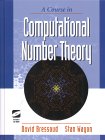Gaussian primes are Gaussian integers satisfying one of the following properties.
1. If both
and
are nonzero then,
is a Gaussian prime iff
is an ordinary prime.
2. If ,
then
is a Gaussian prime iff
is an ordinary prime and
.
3. If ,
then
is a Gaussian prime iff
is an ordinary prime and
.
The above plot of the complex plane shows the Gaussian primes as filled squares.
The primes which are also Gaussian primes are 3, 7, 11, 19, 23, 31, 43, ... (OEIS A002145). The Gaussian primes with are given by
,
,
,
,
,
,
,
,
,
,
,
,
,
,
,
,
,
,
,
,
,
,
,
,
,
,
,
,
,
,
,
,
,
,
,
,
,
, 3,
,
,
,
,
,
,
,
,
.
The numbers of Gaussian primes with complex modulus
(where the definition
has been used) for
, 1, ... are 0, 100, 4928, 313752,
... (OEIS A091134).

The cover of Bressoud and Wagon (2000) shows an illustration of the distribution of Gaussian primes in the complex plane.
As of 2009, the largest known Gaussian prime, found in Sep. 2006, is , whose real and imaginary parts both have
decimal digits and whose squared
complex modulus has
digits.